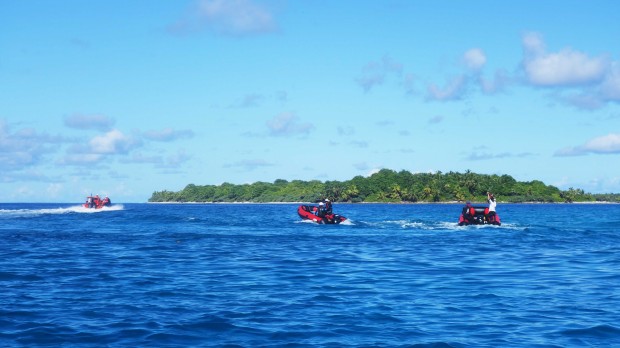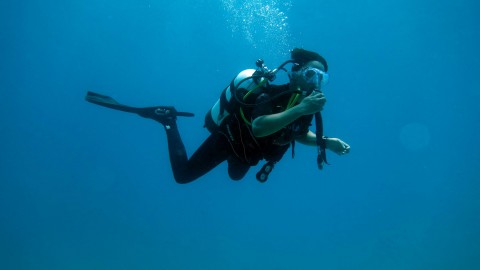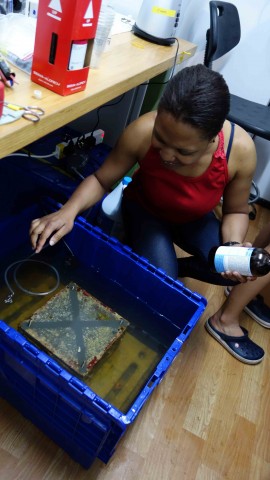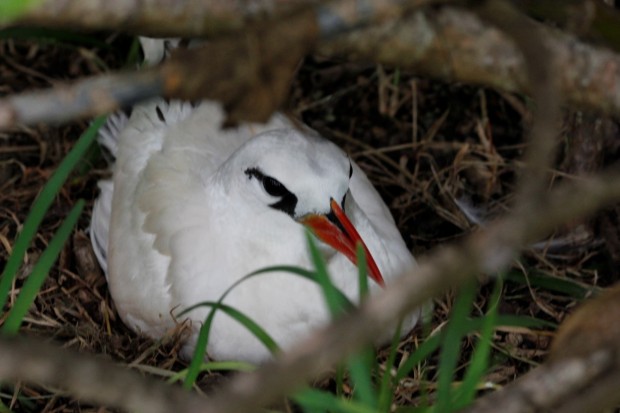2015 Darwin Science Expedition - Day 2 - Getting in for the first dive
Getting in for the first dive
The lead up to some of the activities on these expeditions is impressive – on our first dive of the expedition today we were out looking for reef monitoring devices that were set out more than 2 years ago. Now they’re ready to be collected. This involves dropping in for a dive, searching out the buckets sized blocks, now overgrown by algae and coral and looking just like a part of the seabed, removing them from the secure bars holding them to the reef, then lifting and transporting the heavy load back to the research vessel for processing. And that is still going on late at night while I write up the days activities…more about that later.
Before any of this is possible all of the gear we shipped out, everything stored on shelves for this expedition needs to be unpacked, set up and readied for action. A laboratory has been furnished, four dive compressors set up on the forecastle, 27 dive tanks filled and 13 sets of scuba dive equipment have been assembled – not to mention each individual persons science or research or camera equipment.
With the incentive of some great diving around the lagoon mouth of Diego Garcia all of this activity was given a great deal of effort this morning. Shortly after lunch we headed out into the bright sunshine around the lagoon and made for the Oceanside of Middle Island. This is where the Autonomous Reef Monitoring Systems (ARMS) were set up two years ago.

After two years it took a long while to find the devices – one of them is overgrown with a layer of acropora and looks a lot like a mound of coral on the seabed. Catherine retrieved one of them to process tonight so that is now back on board the research vessel and is being examined as I write.
While she was looking for them I took Claudia, our Connect Chagos graduate, on her first dive in the territory. Amongst other things we saw one of the huge sea cucumbers that are characteristic of the waters around Diego Garcia and also came across a large free swimming Morey Eel. As we approached he went to hide under a ledge but this didn’t stop him from peering out and examing us very closely. Something to be weary of with that big mouth and the accompanying sharp teeth.
VIDEO https://www.youtube.com/watch?v=KKyZPNE1ei0
She thoroughly enjoyed the experience and there will be plenty more opportunity to get under water and enjoy the sights out here!

After a great dive we headed back to the research vessel. We’ve now got everyone out the water and there are some Gremlins to work out of the system. Boat repairs to make and dive gear glitches to rectify. As we’re finishing up with this it looks like the ARMS processing is just getting started though…the devices are made up of numerous plates into which the small reef life creeps and lives. The idea is to separate all of the plates and examine what communities have established themselves in this cryptic fashion. There should be some really interesting inhabitants…time to put down the computer and go and see what discoveries they have made!!

Additional to the marine work we are doing on this expedition Pete Carr is leading research around the terrestrial habitats of the archipelago. His reports will be included in the daily blog...day one's entry below...
Diego Garcia
After arriving on Diego Garcia late on Tuesday night (17th), the following day was taken up with the necessary pre-sailing administration. Working parties were busy all day retrieving stores that had been cached on the island, acquiring the necessary stores for the expedition such as fuel and checking that all the participant’s personnel equipment was functioning and ready to be put in action. Unlike the rest of the expedition members who all had dive equipment to check over, my kit list is fairly simple; binoculars, camera and notebook are my essentials. Rather than checking these out on the ship berthed alongside a jetty, I decided to test them in the field. This proved to be a good decision as I found three pairs of Red-tailed Tropicbird breeding semi-colonially in their traditional site on the island. Bizarrely, they nest directly behind a regularly used soccer goal. This site, first noted in 2003 by Nestor Guzman who works on the island as an environmental advisor, is the only known regularly used area on the only island in the Territory this species is known to breed on!
Today was the first day of true census work on the internationally important breeding seabirds of the Chagos Archipelago. Being berthed in Diego Garcia for three days before sailing is offering a rare opportunity to count the Important Bird Area and Ramsar site on this, by an order of magnitude the largest island in the central Indian Ocean. The three islands, East, Middle and West, in the mouth of the atoll lagoon were surveyed today, not just for birds, also to ensure that rats have not invaded these seabird sanctuaries from the mainland. Miraculously all three islands have remained rat-free, despite East Island once being inhabited. The good news being they are still rat-free and East Island remains a superb example of an oceanic climax forest, in this case dominated by the Native Pisonia grandis trees. The seabirds are faring well too with thriving populations of Red-footed Booby on all three.
Red-tailed Tropicbird photographed breeding on Diego Garcia


